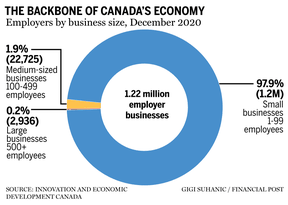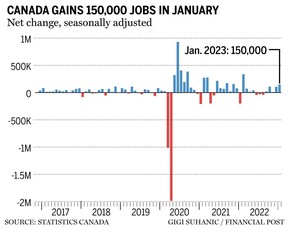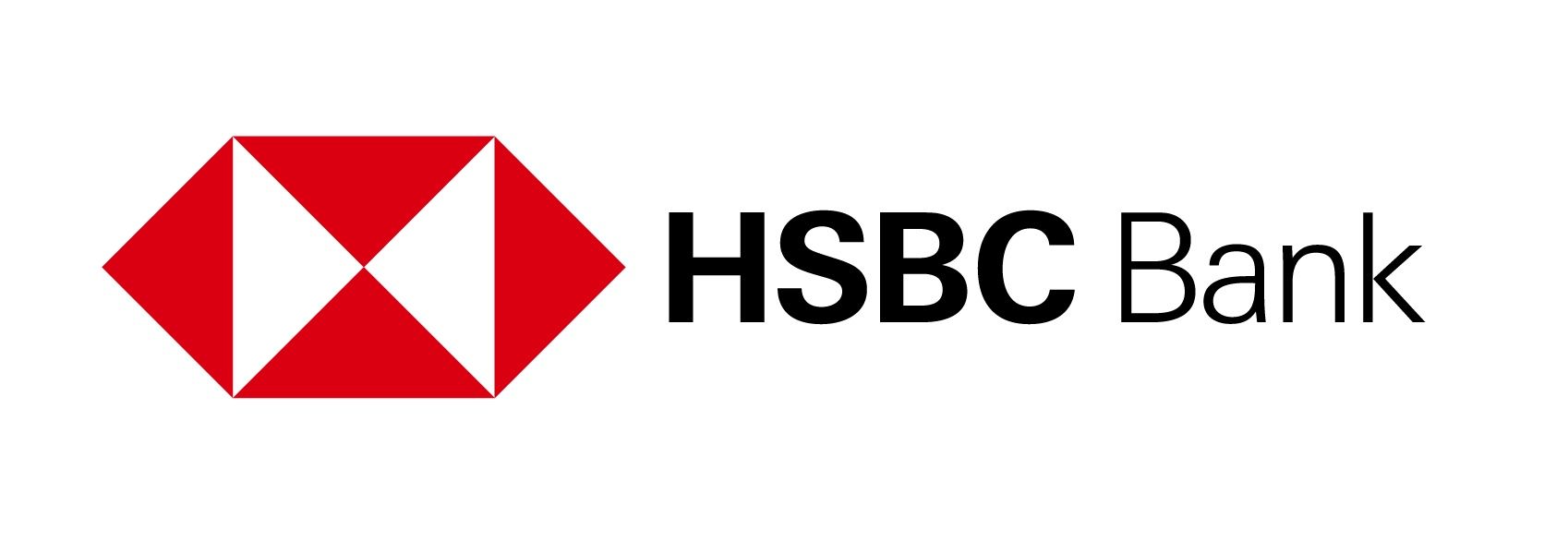Pricier wages and debt repayment weigh as pandemic loans come due this year

Article content
Rashmi Shrestha believes working hard is the key to success.
Advertisement 2
Article content
The Toronto resident, who in September finally realized her dream of owning a restaurant, wakes up at 4 a.m. some days to drive for Uber Technologies Inc., shuttling workers to their jobs before she begins her own.
Article content
“If I stay home, I’m thinking a lot. Better to go, get out, press forward and take the car. And I like the driving,” she said.
Article content
Come 10 a.m., it’s time to open Bowl and Snacks, her pan-Asian eatery that serves samosas, sushi, momos and build-your-own stir fry and curry bowls.
The restaurant in Toronto’s Regent Park neighbourhood closes at 10 p.m. during the week and 9 p.m. on weekends, but Shrestha spends upwards of 14 hours a day at the store, juggling everything from taking orders and cooking to cleaning and driving to Costco for ingredients.
Advertisement 3
Article content
“It’s my business. I wash the dishes, I clean everything. I wash the washrooms. I cannot offer people jobs to hire more, so I have to do it,” said Shrestha, who immigrated to Canada from Nepal about 15 years ago.
It is a very hard time for me
Rashmi Shrestha, owner of Bowl and Snacks
She only has one employee, and she can’t afford to give herself a salary yet, so she calls on her 23-year-old son to help when an extra set of hands is needed.
“It is a very hard time for me,” she said. “This situation is (hard) not only for me, but for everybody. Everybody.”
Indeed, Canada’s small businesses are struggling in an economic climate of elevated inflation, high interest rates and labour shortages, issues that are even more difficult to handle because companies still haven’t regained their footing after COVID-19 lockdowns hammered their earnings. Not to mention, all those government-pandemic business loans many took out are due by year-end.
Article content
Advertisement 4
Article content
Rising costs
The cost of doing business has gotten more expensive, with everything from wages, materials and debt repayment to overhead expenses now pricier than before the pandemic.
At the same time, companies are still trying to recover from lost sales from COVID-19 restrictions. More than half of companies’ sales hadn’t returned to pre-pandemic levels by November, according to the latest data from the Canadian Federation of Independent Business (CFIB), a lobby group that tracks small-business recovery.
There are pandemic-era government loan payments to consider, too. Businesses have until the end of this year to pay back Canada Emergency Business Account (CEBA) loans in full before interest charges kick in.
Advertisement 5
Article content
As the country teeters on the edge of recession brought on by higher interest rates, small- and medium-sized businesses — which together make up 99.8 per cent of Canadian companies — face a long road ahead of economic uncertainty that could force a wave of owners to tack “out of business” signs to storefront windows.

“People forget that we’ve already had a small recession as a result of the pandemic, right when it hit in 2020,” said Marwa Abdou, senior research director at the Canadian Chamber of Commerce.
Numerous entrepreneurs were forced to close shop in the volatility of those early days, she added.
“We’re now facing this onslaught of additional challenges like inflation and labour supply,” Abdou said. “You’d be remiss to underestimate that it is going to take at least two to five years for those businesses to go back to the level in which they were operating prior to the pandemic.”
Advertisement 6
Article content
Those challenges are adding pressure to businesses that operate on already thin margins. Unexpected costs that go into running smaller enterprises are often high.
For example, Shrestha wants to redesign her restaurant’s branding to draw in more customers as business has slowed. But a $2,000 fee to a marketing contractor to redesign her logo has snowballed into another $5,000. In the meantime, her books have been in the red since she opened Bowl and Snacks.
“I can’t afford (that). I still need money,” she said.
Shrestha also has other expenses to worry about, such as spending $800 to fix a range hood, which she has been putting off. Borrowing more money to help fund her costs is almost inconceivable. As it is, she is supposed to begin repaying an initial $75,000 government-backed loan this month, the thought of which keeps her up some nights.
Advertisement 7
Article content
Pandemic loans come due
Though Shrestha opened her restaurant too late to take advantage of pandemic government loans, such as CEBA, other small businesses certainly did.
Nearly 900,000 small enterprises received up to $60,000 each via CEBA loans in 2020 and 2021 after pandemic restrictions forced temporary shutdowns. Owners at the time considered the loans lifelines to keep their companies going amid the unpredictability of COVID-19 waves.
But now, the Dec. 31, 2023, deadline to pay back the loans is looming and there’s a strong incentive to do so. Companies that repay in full by that date are eligible to have up to $20,000 of their balances forgiven.
Huys Industries Ltd., a Toronto manufacturer of resistance welding products used primarily in cars, was a CEBA recipient that took out the maximum loan amount to keep operations running during lockdowns, Clair Scotchmer, vice-president of finance, said.
Advertisement 8
Article content
Where am I going to get that money to pay off the portion that we need to pay off in order to take advantage of this forgivable part?
Clair Scotchmer, vice-president of finance, Huys Industries
The loan helped the company navigate a downturn in sales brought on by supply-chain snarls and material shortages, such as semiconductor chips. Revenue still hasn’t recovered. Year to date, it remains 14 per cent below what it was prior to COVID-19, Scotchmer said.
The company is now gearing up to invest in technology and machinery to stay competitive and boost revenue. For example, it’s considering moving accounting processes to the cloud to connect two Ontario warehouses. But finding the money to do that, while also paying off the CEBA loan, is proving to be a challenge.
“Where am I going to get that money to pay off the portion that we need to pay off in order to take advantage of this forgivable part?” Scotchmer said. “Revenue that didn’t come in during COVID is not going to miraculously reappear.”
Advertisement 9
Article content
It’s hard to make investment decisions when there’s so much uncertainty, she said.
Relief at hand?
Inflation, which peaked in June at eight per cent, has remained well above the Bank of Canada’s target of between one and three per cent. To cool it, the central bank raised interest rates at the fastest clip in its history, putting its benchmark at 4.5 per cent; this time last year, it was near zero.
But, CFIB economist Simon Gaudreault thinks small-business owners may get some relief in the months ahead now that the Bank of Canada has signalled it will pause additional interest rate hikes.
“The pressure on that side of things is not going to continue to build, so there’s one element where small business owners have a bit more certainty,” he said.
Advertisement 10
Article content
But that’s only if inflation continues to decelerate, he added, and slowing inflation doesn’t eliminate higher interest rates overnight.
Monetary policy works at a slower pace, with the Bank of Canada typically raising and lowering its overnight policy rate at a measured speed to avoid shocking the economy. Policymakers don’t see inflation returning to the two-per-cent target until next year, which means interest rates will likely remain high until then.

A tight labour market, marked by shortages of skilled workers and demands for higher wages, is complicating the picture.
The labour market has proved resilient even as interest rates rose, and employers’ hiring appetite remains strong. Companies added 150,000 workers in January, blowing past forecasters’ expectations of a tenth of that number. The unemployment rate is also near record lows and job vacancies are high, which means it’s harder for companies to find staff.
Advertisement 11
Article content
As a result, wages have climbed, growing at an annual rate of at least five per cent in the latter half of last year, which is not enough to keep pace with soaring goods and services prices, but is still above the central bank’s overall inflation target.
“The worst-case scenario is that then you have long-run labour shortages that sustain inflation,” Abdou said, since that will complicate the central bank’s efforts to take steam out of the economy with rates already at the highest they’ve been in 15 years.
Sustained higher interest rates would also make small-business owners’ lives more difficult by keeping borrowing costs elevated for longer.
Labour shortage
Kieran Burger-Dunning has felt the impact of labour shortages first hand. He owns and runs Knick Knack Paddywhack, a boutique pet store geared towards dog owners, which has two locations in Toronto’s east end and a third on the way.
Advertisement 12
Article content
“Compared to other small businesses, we had it very lucky because everyone knows the pandemic puppy boom kind of took off,” he said. “So it wasn’t a bad business to be in.”
But a shortage of labour in the city — for dog groomers, in his case — is one of the reasons why the third location won’t offer grooming services like the other two, at least to start. Instead, Burger-Dunning is considering turning what would have been the grooming space inside the new store into a mini warehouse to support e-commerce and local delivery.
When your hands are tied and you’re just trying to make do, it’s … a much more muted prospect of growth at least in the short- to medium-term
Marwa Abdou, senior research director, Canadian Chamber of Commerce.
And he won’t be bringing on any new employees for at least six to nine months after he opens the third Knick Knack Paddywhack towards the end of spring.
“It’s also going to help us keep those labour costs down, just until we can kind of see how things are going,” he said.
Advertisement 13
Article content
With grooming a big part of what makes the store’s other locations successful, he’s uncertain of how business will look without that key service.
“When your hands are tied and you’re just trying to make do, trying to keep your head above water because you’re bombarded by all these challenges, it’s … a much more muted prospect of growth at least in the short- to medium-term,” Abdou said of business owners.
It’s enough to push many small business owners to the exit. More than one in 10 small- and medium-sized business owners want to bow out in the next decade because of financial impacts from the pandemic, while more than a fifth want to leave because of stress and burnout, according to a CFIB report in January.
Reason for optimism
Advertisement 14
Article content
Still, Gaudreault, the CFIB economist, said there’s reason to be optimistic about the small-business sector, even if many owners are worried about the future.
“The small-business sector and entrepreneurs are so important. They are the ones who will come up with new business models, those ideas to solve the issues that keep piling up,” he said. “I’m relatively confident about the medium-long term,” he said, noting that macro pressures will ease eventually.
-

Business insolvencies up 55% in January compared to 2022
-

Nordstrom joins the exodus of U.S. retailers from Canada: What you need to know
-

‘Inappropriate’: Indigo refuses to pay ransom in cyberattack possibly linked to Russians
Shrestha, the owner of Bowl and Snacks, is also hopeful for the future. She’s optimistic she can drum up more business at her Toronto restaurant and is confident her health-conscious food will bring in customers.
She’s also betting she can attract a following by getting her food featured in TikTok videos, and plans to hire a marketing manager. Until then, there are still the usual costs to manage and more hard work ahead.
“I’m going to work, just myself, to save money.”
• Email: bbharti@postmedia.com | Twitter: biancabharti
Small businesses struggle with inflation as pandemic loans come due
2023-03-07 16:22:16








Comments
Postmedia is committed to maintaining a lively but civil forum for discussion and encourage all readers to share their views on our articles. Comments may take up to an hour for moderation before appearing on the site. We ask you to keep your comments relevant and respectful. We have enabled email notifications—you will now receive an email if you receive a reply to your comment, there is an update to a comment thread you follow or if a user you follow comments. Visit our Community Guidelines for more information and details on how to adjust your email settings.
Join the Conversation